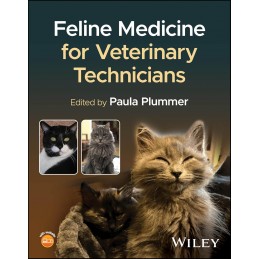- Reduced price
- New

Order to parcel locker

easy pay


 Delivery policy
Delivery policy
Choose Paczkomat Inpost, Orlen Paczka, DHL, DPD or Poczta Polska. Click for more details
 Security policy
Security policy
Pay with a quick bank transfer, payment card or cash on delivery. Click for more details
 Return policy
Return policy
If you are a consumer, you can return the goods within 14 days. Click for more details
A comprehensive overview of feline medicine in a clinical setting for the veterinary technician
Feline Medicine for Veterinary Technicians is a complete, specialty reference guide, written by veterinary technician specialists, for the veterinary technician to use in a feline medicine clinical setting. Covering everything from the pathophysiology of common feline diseases, current therapies and nursing care, diagnostic techniques, unique history taking methods, and nursing care in every major body system. It is a critical tool for anyone preparing for a specialty exam or the Veterinary Technician National Exam (VTNE).
Feline Medicine for Veterinary Technicians readers will also find::
Feline Medicine for Veterinary Technicians is ideal for students as well as anyone preparing for a specialty exam or as a veterinary technician in feline clinical practice.
Data sheet
List of Contributors xxiii
Preface xxv
Acknowledgment xxvii
About the Companion Website xxix
Section 1 The Cat and Special Considerations 1
1 Feline Behavior 3
Monique Feyrecilde BA, LVT, VTS (Behavior), Elite FFCP Veterinary
1.1 Sensation and Perception 3
1.2 Feline Body Language 5
1.3 Community Behavior in Cats 7
1.4 Sexual Behavior in Cats 8
1.5 Elimination Behaviors 8
1.6 How Cats Learn and Modifying Behaviors 8
1.7 Functional and Applied Behavior Analysis 13
1.8 Common Unwanted Behaviors 16
1.9 Behavior Emergencies 20
1.10 Incorporating Behavior into Everyday Veterinary Practice 20
2 Feline-Friendly Interactions 23
Ellen M. Carozza, LVT, VTS (CP-Feline)
2.1 Understanding Cat Emotions and Their Motivations 24
2.2 Be Respectful, Remain Professional; Words Matter 25
2.3 Feline Emotions: Engaging and Protective - Both Are Normal! 26
2.4 Sensory Communication Cats: How Cats Gather and Interpret Information 27
2.5 Interpreting Feline Behaviors at the Clinic and Modifying Our Techniques to Prevent Escalation 28
2.6 Setting Yourself Up for Success 31
2.7 Stressor Stacking: Understanding Stressors that Contribute to Difficult Visits 31
2.8 Making Changes at the Clinic 33
2.9 Know Your Cats: They Are Communicating! 35
2.10 Handling Techniques 36
2.11 Sedation 38
2.12 Tips for Safe and Feline-friendly Life Stage Handling: A New Way to Approach Cats 40
3 Preparing the Veterinary Hospital for the Feline Patient 43
Jan Yaroslav RVT, VTS (Dentistry), VTS (CP-Feline)
3.1 General Clinic Preparation for a Feline Visit 43
3.2 The Reception Area 45
3.3 The Exam Room 46
3.4 The Treatment Room 48
3.5 The Surgical Suite 49
3.6 The Hospitalization Ward 49
3.7 Training the Team 51
3.8 How to Become a Cat Friendly Practice® 52
3.9 Resources for Veterinary Professionals 52
3.10 Resources for Clients 53
4 Life Stage Considerations 55
Ann Wortinger BIS, LVT, VTS (ECC) (SAIM) (Nutrition), Elite FFCP
4.1 Kitten 55
4.2 Junior 57
4.3 Prime 59
4.4 Mature 60
4.5 Senior 62
4.6 Geriatric 62
4.7 Body Condition Scoring 64
4.8 Body Condition Score Uses 66
4.9 Diagnostic Techniques 66
5 Client Education and Communication Topics for the Feline Owner 69
Christina M. Daigle, LVT, VTS (CP-C/F)
5.1 Types of Communication 69
5.2 Obtaining a Medical History 70
5.3 Home Environmental Factors 71
5.4 Preparing for the Veterinary Visit 75
5.5 Nutrition 77
5.6 Nursing Care for the Feline Pet Owner 78
5.7 Client Communication and Feline Disease Management 83
6 Anesthetic Considerations for the Feline Patient 97
Lanette Jordan, BS, LVT, VTS (Anesthesia and Analgesia)
6.1 Preanesthetic Phase 99
6.2 Anesthetic Phase 101
6.3 Recovery Phase 122
7 Analgesic Considerations for the Feline Patient 125
Lanette Jordan BS, LVT, VTS (Anesthesia and Analgesia)
7.1 The Pain Pathway 127
7.2 Types of Pain 128
7.3 Negative Effects of Pain 128
7.4 Assessment of Pain 129
7.5 Pain Scoring Instruments 130
7.6 Treatment of Pain 135
8 Introduction to Feline Pharmacology 147
Ann Wortinger BIS, LVT, VTS (ECC) (SAIM) (Nutrition), Elite FFCP
8.1 Unique Pharmacokinetics for the Feline Patient 147
8.2 Metabolism 147
8.3 Acetylation 150
8.4 Methylation 150
8.5 Renal Excretion 150
8.6 Medications with Unique Pharmacokinetics in the Feline Patient 150
8.7 Introduction and Current Guidelines of Antimicrobial Stewardship 162
9 Feline Immunology and Current Vaccination Guidelines 165
Ellen M. Carozza, LVT, VTS (CP-Feline)
9.1 Vaccine History 166
9.2 How Vaccines Work 166
9.3 Natural Immunity: Maternal Derived Antibodies 166
9.4 Feline Injection Site Sarcoma 166
9.5 Vaccination Administration Sites 168
9.6 Vaccine Site Monitoring 168
9.7 Vaccine Hypersensitivity 168
9.8 Vaccination Types 169
9.9 Routes of Administration 169
9.10 Feline Core Vaccines 170
9.11 Feline Noncore Vaccinations 175
9.12 Vaccines No Longer Recommended 176
9.13 Feline Patient Populations That Need Protection: What and When to Provide Vaccination 176
9.14 Vaccination and Age 178
9.15 Lifestyle Vaccinations: When Vaccination Plans Have the Possibility of Changing 178
9.16 Postvaccination Serological Screening: The Debate on Over-vaccination 180
9.16.1 Serology Testing is Useful for Assessment of Immunity: Antibody Testing 180
9.17 Staff Compliance: Who Is Responsible for What? 181
Section 2 Feline Patient Care 185
10 Critical Thinking and Kirby’s Rule of 20 187
Courtney Waxman, MS, CVT, RVT, VTS (ECC)
10.1 Veterinary Medical Error Background 187
10.2 Patient Care Checklist Background 188
10.3 Kirby’s Rule of 20 188
10.4 Critical Thinking 203
11 Interpretation of Common Diagnostics Test Results 207
Ann Wortinger, BIS, LVT, VTS (ECC) (SAIM) (Nutrition), Elite FFCP
11.1 Use of a Microscope 207
11.2 Care and Maintenance of a Microscope 208
11.3 Interpretation of Common Diagnostic Tests 209
11.4 Diagnostic Techniques 220
12 General Feline Nutrition 225
Ann Wortinger, BIS, LVT, VTS (ECC) (SAIM) (Nutrition), Elite FFCP
12.1 Feeding Behaviors 225
12.2 Anatomic Adaptations 226
12.3 Physiologic Adaptations 226
12.4 Metabolic Adaptations 227
12.5 Fixed Taste Preferences and Food Aversions 229
12.6 The Association of American Feed Control Officials Life Stages 229
12.7 Reproduction and Neonatal Nutrition 230
12.8 Orphaned Kitten Nutrition 230
12.9 Kitten Nutrition 232
12.10 Young Adult Nutrition 233
12.11 Mature Adult Nutrition 235
12.12 Geriatric Nutrition 235
12.13 Feeding Tubes: Uses, Indications, and Placement 236
12.14 Diagnostic Techniques 239
13 Feline Wound Care and Bandaging 243
Kelly M. Foltz, BA, AAT, CVT, LVT, RVT, VTS (ECC)
13.1 Etiology of Feline Wounds 243
13.2 Wound Physiology 244
13.3 Wound Classification 245
13.4 Wound Healing 246
13.5 Approach to the Feline Trauma Patient 247
13.6 Wound Care and Management 251
13.7 Bandage Techniques 254
13.8 Wound Drains 257
13.9 Emerging Wound Management Techniques 258
13.10 Burn Care 259
Section 3 Feline Systems, Diseases, and Conditions 263
14 Cardiology/Cardiovascular Diseases 265
Kristie Garcia, LVT, VTS (Cardiology)
14.1 Patient History and History Gathering Questions 266
14.2 Clinical Signs 267
14.3 Physical Examination Findings 268
14.4 Specific Nursing Care Considerations 269
14.5 Cardiovascular Diseases 270
14.6 Cardiomyopathy Prognosis 274
14.7 Comorbidities to Consider 275
14.8 Cardiovascular Emergencies 276
14.9 Diagnostic Techniques 278
15 Dentistry 285
Jan Yaroslav RVT, VTS (Dentistry), VTS (CP-Feline)
15.1 Feline Dental Anatomy 285
15.2 Patient History and History Gathering Questions 286
15.3 Dental Equipment 286
15.4 Ergonomics 289
15.5 Dental Radiography 290
15.6 The Feline Oral Exam 293
15.7 The Professional Dental Cleaning 293
15.8 Dental Charts 294
15.9 Tooth Numbering Systems 294
15.10 Nomenclature and Abbreviations 294
15.11 Oral Pathology 294
16 Dermatology and Auricular Conditions 301
Amanda Friedeck, BS, LVT, VTS (Dermatology)
16.1 Patient History and History Gathering Questions 301
16.2 Clinical Signs 301
16.3 Physical Examination Findings 302
16.4 Specific Nursing Care Considerations 302
16.5 Basic Feline Dermatology 302
16.6 Allergic Reaction Patterns 303
16.7 Hypersensitivity Reactions 306
16.8 Facial Dermatosis 311
16.9 Feline Auricular Anatomy and Conditions 313
16.10 Diagnostic Techniques 318
17 Emergency and Critical Care 321
Kelly M. Foltz, BA, AAT, CVT, LVT, RVT, VTS (ECC)
17.1 Patient History and History Gathering Questions 321
17.2 Feline Interactions in the ER 322
17.3 Clinical Signs 322
17.4 Physical Examination Findings 322
17.5 Triage 323
17.6 The Feline Inpatient 324
17.7 Specific Nursing Care Considerations 325
17.8 Common Emergencies by Body System 327
17.9 Diagnostic Techniques 344
18 Endocrinology 351
Paula Plummer, LVT, VTS (ECC, SAIM, CP-fe)
18.1 Patient History and History Gathering Questions 351
18.2 Clinical Signs 352
18.3 Physical Examination Findings 353
18.4 Specific Nursing Care Considerations 354
18.5 Endocrine Disorders 354
18.6 Diagnostic Techniques 365
19 Gastroenterology 371
Chastity Ketchum, LVT, VTS (Internal Medicine-SA)
19.1 Patient History and History Gathering Questions 372
19.2 Clinical Signs 373
19.3 Physical Examination Findings 375
19.4 Specific Nursing Care Considerations 376
19.5 Gastrointestinal Disease in the Feline Patient 377
19.6 Diagnostic Techniques 386
20 Gestation, Lactation, and Pediatrics 391
Ellen M. Carozza, LVT, VTS (CP-Feline)
20.1 Breeding in Cats: So Many Kittens in Such Little Time 391
20.2 Pregnancy and Birth 393
20.3 Dystocia 396
20.4 Appearance, Pulse, Grimace, Activity, and Respiration Scoring in Neonates: Know Their Vitality Early on! 397
20.5 Nursing and Lactation 400
20.6 Kitten Mortality 400
20.7 Postpartum Complications in the Queen 401
20.8 Kitten Care 401
20.9 Bottles and Tube Feeding; What Can Be Used for Orphaned Kitten Feeding and How to Perform Tube Feeding When Necessary 402
20.10 Milestones 403
20.11 Kitten Nutrition 404
20.12 Weaning the Kitten 404
20.13 The Critical Neonate 405
21 Hematology 411
Camille Kelly, CVT, VTS (ECC)
21.1 Patient History and History Gathering Questions 414
21.2 Clinical Signs 414
21.3 Physical Examination Findings 414
21.4 Specific Nursing Care Considerations 415
21.5 Red Blood Cell Conditions 415
21.6 White Blood Cell Conditions 419
21.7 Coagulopathies 420
21.8 Diagnostic Techniques 422
21.9 Feline Blood Donors 426
21.10 Blood Component Processing 431
22 Hepatobiliary 435
Paula Plummer, LVT, VTS (ECC, SAIM, CP-fe)
22.1 Patient History and History Gathering Questions 437
22.2 Clinical Signs 437
22.3 Physical Examination Findings 438
22.4 Specific Nursing Care Considerations 438
22.5 Diseases of the Liver 439
22.6 Diseases of the Gallbladder and Bile Duct 443
22.7 Diseases of the Exocrine Pancreas 446
22.8 Triaditis 448
22.9 Diagnostic Techniques 448
23 Feline Infectious Diseases 453
Paula Plummer, LVT, VTS (ECC, SAIM, CP-fe)
23.1 History-gathering Questions 453
23.2 Clinical Signs 453
23.3 Physical Examination Findings 455
23.4 Nursing Care Considerations 455
23.5 Bacterial Infectious Diseases 456
23.6 Systemic Fungal Infectious Diseases 457
23.7 Protozoal Infectious Diseases 461
23.8 Viral Infectious Diseases 463
23.9 Diagnostic Techniques 469
24 Oncology 473
Jaci Christensen, BAS, LVT, VTS (Oncology)
24.1 Patient History and History Gathering Questions 473
24.2 Clinical Signs 474
24.3 Physical Examination Findings 474
24.4 Specific Nursing Care Considerations 474
24.5 Treatment Modalities 474
24.6 Common Feline Neoplasms 478
24.7 Diagnostic Techniques 484
24.8 Chemotherapy Administration 486
25 Respiratory 491
Paula Plummer, LVT, VTS (ECC, SAIM, CP-fe)
25.1 Patient History and History Gathering Questions 493
25.2 Clinical Signs 494
25.3 Physical Examination Findings 494
25.4 Specific Nursing Care Considerations 495
25.5 Oxygen Supplementation 498
25.6 Respiratory Diseases 499
25.7 Diagnostic Techniques 504
26 Urinary and Renal 507
Rhonda South-Bodiford, LVT, VTS (SAIM)
26.1 Patient History and History Gathering Questions 507
26.2 Clinical Signs 508
26.3 Physical Examination Findings 508
26.4 Specific Nursing Care Considerations 509
26.5 Renal and Urinary Diseases 509
26.6 Diagnostic Techniques 516
References 524
Index 525
